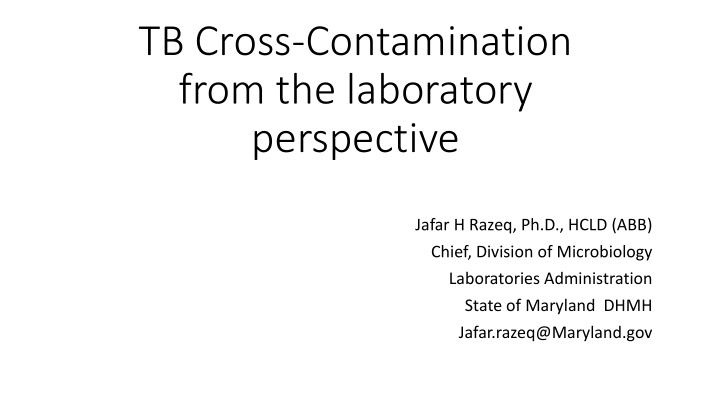



TB Cross-Contamination from the laboratory perspective Jafar H Razeq, Ph.D., HCLD (ABB) Chief, Division of Microbiology Laboratories Administration State of Maryland DHMH Jafar.razeq@Maryland.gov
The J. Mehsen Joseph Public Health Laboratory
New Home State of Maryland Department of Health and Mental Hygiene Laboratories Administration 1770 Ashland Ave Baltimore, Md. 21205
TB Cross-Contamination “False - Positive Cultures”
Consequences of false positive cultures: • First and foremost: exposes the patient to unnecessary, and potentially toxic treatment, hospitalization, isolation, and anxiety • Unnecessary follow-up and contact investigation • Unnecessary laboratory tests and work • Potential legal aspects
• Rates of false positive cultures has been reported to be ranging from 2.2%-10.5% • Most common causes of false positive cultures are clerical errors, contamination of clinical equipment, and laboratory cross- contamination • Laboratory cross-contamination is the mostly described and documented
Causes of False-Positive Cultures I. CLERICAL ERRORS: MISLABELING The clerical errors have been associated with mislabeling of specimens leading to a false-positive culture result. There is limited data on this issue.
Causes of False-Positive Cultures II. CONTAMINATION OF CLINICAL EQUIPMENT Contamination of clinical equipment (e.g., bronchoscope) can cause false- positive culture. A contaminated device can cause both false-positive cultures and tuberculosis transmission.
Causes of False-Positive Cultures III. LABORATORY CROSS-CONTAMINATION Our topic for today.
Definition of Laboratory Cross Contamination The transfer of MTB complex bacilli from one specimen to another specimen that does not contain viable bacilli, causing a false- positive result. APHL Training Module
Causes of Cross-Contamination - how it happens: • No environmental reservoir for MTB, but it is hardy organism and can survive harsh conditions. • Creation of aerosol or splashing during specimen processing • Defects in the exhaust systems of the BSCs used for specimen processing. The creation of an aerosol when samples are processed that is not cleared promptly (through a functional BSC) may lead to the settlement of these particles in the subsequent specimen
Causes of Cross-Contamination - how it happens: • Use of common flask to dispense reagents. • Specimen carryover, spillage, or inadvertent contamination during specimen processing. • Contamination of pipettes or lids. • Batch processing of specimen is the efficient way of testing, but carries the potential for cross-contamination due to contamination common reagents like the buffer.
Causes of Cross-Contamination - how it happens (continued): • Processing excessive number of specimens in one batch due to staff shortages may lead to breakdown in protocol adherence and introduce potential error for cross-contamination.
To reduce the possibility of Cross-Contamination: • Use daily aliquots of processing reagents and buffers. Any leftover should be discarded. • Never use common beakers or flasks when processing. • Keep the specimen tubes tightly closed and clean the outside of the tube prior to vortexing or shaking. • Pour decontamination reagents or buffers slowly on the side of the tube without causing any splashing. Do not touch the container of reagents to the lip of the tube at any time during addition.
To Reduce the Possibility of Cross-Contamination(continued): • Only one tube should be uncapped at a time. • After mixing or vortexing, wait for five (5) minutes before uncapping the tubes. • Open the specimen tubes very gently to avoid aerosol generation. • When adding reagents to the tube, open one tube at a time. Do not keep all the tubes open at the same times.
To Reduce the Possibility of Cross-Contamination (continued): • Establishment of a threshold which, when exceeded, will prompt an investigation. • Standardizing of laboratory procedures. • Do not place tubes too close to each other in the rack. • Change gloves often. • Avoid manipulation of PT specimens. • Disinfect Biological Safety Cabinet (BSC) work surfaces routinely.
Criteria (i.e., red flags) that might trigger false-positive culture investigation: • The problem is that some of these red flags are also seen in true TB patients • Patient’s clinical course is inconsistent with TB and the clinician is considering an alternative diagnosis. • Single positive M. tuberculosis culture with no AFB seen in any specimen (although this can also be seen in true TB patients). • Time to growth detection is > 30 days (this can also be seen in true TB patients). • Clustering of MTB isolates with unusual resistance pattern in a short period of time.
Criteria (i.e., red flags) that might trigger false-positive culture investigation (continued): • If MTB is cultured from a sample processed together with a smear positive specimen. • Usually, specimens of false positive cultures are negative for AFB smear. • Cultur ure-pos positi itive e specim cimen en from a di differ erent ent patient ent proces cessed sed or handled ed on t the e same day has an identi tical cal DNA finger erpr print int and no epidemi miol ologic c links s exist betw tween en patients ents.
Reporting Language “ Molecular genotyping tests performed at a reference laboratory on this particular isolate show that cross-contamination with Mycobacterium tuberculosis (MTB) from an extraneous source cannot be ruled out. Please interpret the positive report of MTB from this particular specimen with caution. If clinically warranted, please resubmit another specimen for further testing. As always, laboratory results cannot replace or override clinical judgment in the di diagnosi sis s and ma d manageme ement nt of this patient. If further consultation on this case is needed, please consult the State TB Program at 410-767-6698. For laboratory related questions, call 410-767-6130/6125 ”
Bottom line: Treat patients, not laboratory results”
References Chest, 2013; 144(1):319-322 MMWR, 2011; 49(19):413-416 Chest, 2010; 137(5):1065-1070 EID, 2002; 8 (11); 1260-1263 CID, 2000; 31: 1390-1395 Diag Micro Inf Dis, 2012; 73: 343-349 Clin Micro Rev, 2006; 658-685 Internal Med J, 2002; 512-519 CID, 2004; 38(15): e53-e54 JCM, 2006; 44(8): 2967-2969 Clin Micro Inf Dis, 2006; 12(10): 1042-1045 Arch Pathol Lab Med, 2000; 124: 902-903
Recommend
More recommend